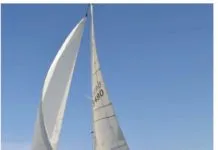Two articles this month focus on the simplest, most reliable form of steering, one that has persisted through the ages with little modification—the tiller. According to researchers, the origins of the modern tiller goes back to China’s Fifth Dynasty (circa 1000 AD), although steering oars were used for centuries before then. The leap from steering oar to tiller is a small one, so I doubt we’ll ever know for sure when the first tiller appeared.
Providing instantaneous feedback through the rudder, the tiller creates an intimate connection between the sailor and the sea. No linkages or gears delay response or dampen forces on the rudder. The simple device offers a mechanical advantage in the most basic form—the lever arm, which along with the wedge was among our first mechanical tools used to master gravity.
The most basic (and potentially destructive) tool in our toolbox, the hammer, is reminder of how potent a simple lever can be, for your claw hammer is nothing more than a lever connected to a chunk of iron.
I digress. My point is that although it is easy to romanticize the tiller (as I did in my blog post “Tiller vs. Wheel” years ago), it is an eminently practical steering solution for sailors of mid-size cruising boats. While 30 feet length overall is the usual point when wheel steering becomes an option, I’ve sailed tiller-steered boats as large as the Cape George 36 (12 tons displacement). Sure, your forearm gets a workout in a seaway, but on a well-balanced boat like the Cape George, the strain is a modest sacrifice for the gains—direct feedback, simplicity, and cockpit space.
My return to this topic was prompted in part by the next phase of refitting Opal, my 1971 Sparkman & Stephens designed Yankee 30. The boat was originally set up for tiller steering, but a subsequent owner fitted a wheel. He also reorganized engine controls and running rigging to suit the new arrangement. I’ve been told this was because the owner was a serious racer. The next owner (a more pragmatic type, I presume) yanked the wheel and went back to the tiller, which Opal has today.
I can understand why a racing sailor would prefer the wheel. It can be quicker to tack. And for most people accustomed to driving cars (which were first steered by tillers, by the way), it is easier to regulate the amount of helm applied. Being able to visually check the degree of helm movement in relation to the horizon, the natural reference point for human perception, also can make wheel steering more intuitive.
You can, of course, draw an artificial “horizon” down the cockpit centerline to better perceive degrees of helm when using a tiller, but there’s something to be said about sailing blind—responding to the wind and sea with all of your senses.
One of the main reasons I won’t return to wheel for Opal has nothing to do with sailing, but with being at rest. By simply lifting the rudder up and out of the cockpit, I’ve more than doubled the available space. And even when sailing, I find it easier to fit four people in the cockpit than I could with a wheel.
And for those of us who cherish moments alone at sea as much as we like having friends aboard, the tiller allows a nearly foolproof, direct connection with a tillerpilot or the steering lines on a self-steering windvane.
The tiller, you might say, is the voyaging ambivert’s best friend.





































I sailed a Yankee 30 for 10 years — tiller steering — and recently moved up to a “big sister” of the Yankee, an S&S-designed SHE 36 — also with tiller. It seems like most 36s have a wheel, but I’ve had no regrets on the tiller configuration. Of course, it’s what I’m used to. But the simplicity and reliability are real considerations when bluewater sailing, and the extra room in the cockpit is appreciated too. Boats from the 70s just don’t have the same room aft that newer designs do.